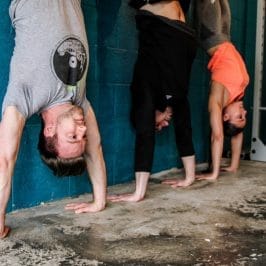[vc_row][vc_column][vc_row_inner][vc_column_inner][vc_column_text]
World-Class Fitness in 100 Words
■ Eat meat and vegetables, nuts and seeds, some fruit, little starch and no sugar. Keep intake to levels that will support exercise but not body fat. ■ Practice and train major lifts: Deadlift, clean, squat, presses, C&J, and snatch. Similarly, master the basics of gymnastics: pull-ups, dips, rope climb, push-ups, sit-ups, presses to handstand, pirouettes, flips, splits, and holds. Bike, run, swim, row, etc, hard and fast. ■ Five or six days per week mix these elements in as many combinations and patterns as creativity will allow. Routine is the enemy. Keep workouts short and intense. ■ Regularly learn and play new sports -Greg Glassman
Why do so many people struggle with gymnastic movements? Why is spatial awareness such a complicated concept for a large percentage of athletes? How can you become better at weightlifting? The short answer, fundamental gymnastics training.
According to Greg Glassman’s “How to Build World Class Fitness in 100 Words,” 50% of the movements listed are gymnastic movements. Also, on the “Pyramid of CrossFit,” mastering gymnastics comes before weightlifting! I think it’s safe to say we all can benefit in CrossFit from gymnastics whether you’re just a beginner or an advanced games athlete.
Interestingly enough, most people believe that if they are struggling with gymnastics, they need to work on technique and mobility; while that is true, they first need to work on building more strength. This can be accomplished in part by weight lifting, but weightlifters can also become stronger by working on their gymnastic skills. This is the beauty of CrossFit! If you want to increase your shoulder strength for a handstand push-up, shoulder pressing is an option, but so is doing handstand holds. Or, are you wanting to improve your core strength when doing Olympic movements? Doing L-sits, planks, and v-ups are hugely beneficial to increase core stabilization. If that isn’t enough, here are a few more benefits of gymnastic training; strength, control, coordination, spatial awareness, movement quality, and mobility.
We find that most people spend the largest amount of time practicing olympic weightlifting or learning “fun” skills like double-unders. Rarely do we see people practicing their kipping swing, mastering a set of strict pull-ups, bettering their footwork for rope climbs, or even improving their form when it comes to an air squat or a push up. Gymnastic movements are not always enjoyable, nor is it just about getting from point A to point B. It’s about the grace and skill demonstrated between the start and finish of a rep that will ultimately enhance the proficiency of the movement.
Will it take time and dedication to become a more well rounded athlete? Absolutely. And that’s why we are offering an 8-week course starting September 11th. If you’re ready to take your training to the next level, contact me at [email protected] for more details.
“The gymnastics modality comprises of body weight elements or calisthenics, and its primary purpose is to improve body control by improving neurological components like coordination, balance, agility, and accuracy, and to improve functional upper body capacity and trunk strength.” –The CrossFit Training Guide, 2006
-Coach Meagan[/vc_column_text][/vc_column_inner][/vc_row_inner][/vc_column][/vc_row]

